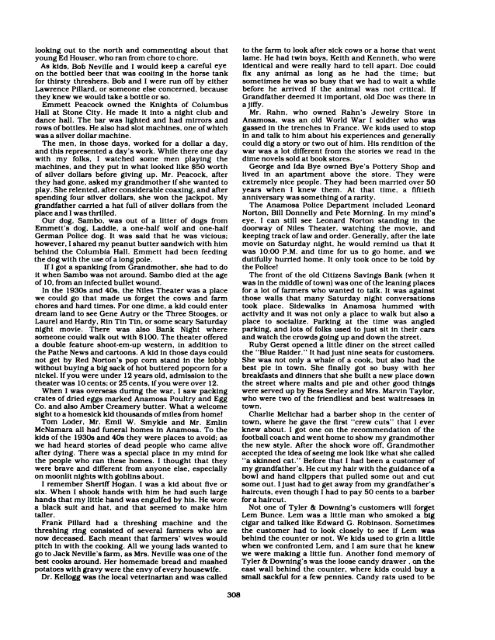Anamosa - A Reminiscence 1838 - 1988
The definitive history of the community of Anamosa, Iowa, USA
The definitive history of the community of Anamosa, Iowa, USA
You also want an ePaper? Increase the reach of your titles
YUMPU automatically turns print PDFs into web optimized ePapers that Google loves.
looking out to the north and commenting about that<br />
young Ed Houser. who ran from chore to chore.<br />
As kids. Bob Neville and I would keep a careful eye<br />
on the bottled beer that was cooling in the horse tank<br />
for thirsty threshers. Bob and I were run off by either<br />
Lawrence Pillard. or someone else concerned. because<br />
they knew we would take a bottle or so.<br />
Emmett Peacock owned the Knights of Columbus<br />
Hall at Stone City. He made it into a night club and<br />
dance hall. The bar was lighted and had mirrors and<br />
rows of bottles. He also had slot machines. one of which<br />
was a silver dollar machine.<br />
The men. in those days. worked for a dollar a day.<br />
and this represented a day's work. While there one day<br />
with my folks. I watched some men playing the<br />
machines. and they put in what looked like $50 worth<br />
of silver dollars before giving up. Mr. Peacock. after<br />
they had gone. asked my grandmother if she wanted to<br />
play. She relented. after considerable coaxing. and after<br />
spending four silver dollars. she won the jackpot. My<br />
grandfather carried a hat full of silver dollars from the<br />
place and I was thrilled.<br />
Our dog. Sambo. was out of a litter of dogs from<br />
Emmett's dog. Laddie. a one-half wolf and one-half<br />
German Police dog. It was said that he was vicious:<br />
however. I shared my peanut butter sandwich with him<br />
behind the Columbia Hall. Emmett had been feeding<br />
the dog with the use of a long pole.<br />
If I got a spanking from Grandmother. she had to do<br />
it when Sambo was not around. Sambo died at the age<br />
of I0. from an infected bullet wound.<br />
In the 1930s and 40s. the Niles Theater was a place<br />
we could go that made us forget the cows and farm<br />
chores and hard times. For one dime. a kid could enter<br />
dream land to see Gene Autry or the Three Stooges. or<br />
Laurel and Hardy. Rin Tin Tin. or some scary Saturday<br />
night movie. There was also Bank Night where<br />
someone could walk out with $100. The theater offered<br />
a double feature shoot-em-up western. in addition to<br />
the Pathe News and cartoons. A kid in those days could<br />
not get by Red Norton's pop com stand in the lobby<br />
without buying a big sack of hot buttered popcorn for a<br />
nickel. If you were under 12 years old. admission to the<br />
theater was I0 cents; or 25 cents. if you were over I2.<br />
When I was overseas during the war. I saw packing<br />
crates of dried eggs marked <strong>Anamosa</strong> Poultry and Egg<br />
Co. and also Amber Creamery butter. What a welcome<br />
sight to a homesick kid thousands of miles from home!<br />
Tom Loder. Mr. Emil W. Smykle and Mr. Emlin<br />
McNamara all had funeral homes in <strong>Anamosa</strong>. To the<br />
kids of the 1930s and 40s they were places to avoid: as<br />
we had heard stories of dead people who came alive<br />
after dying. There was a special place in my mind for<br />
the people who ran these homes. I thought that they<br />
were brave and different from anyone else. especially<br />
on moonlit nights with goblins about.<br />
I remember Sheriff Hogan. I was a kid about flve or<br />
six. When I shook hands with him he had such large<br />
hands that my little hand was engulfed by his. He wore<br />
a black suit and hat. and that seemed to make him<br />
taller.<br />
Frank Pillard had a threshing machine and the<br />
threshing ring consisted of several farmers who are<br />
now deceased. Each meant that farmers‘ wives would<br />
pitch in with the cooking. All we young lads wanted to<br />
go to Jack Neville's farm. as Mrs. Neville was one of the<br />
best cooks around. Her homemade bread and mashed<br />
potatoes with gravy were the envy of every housewife.<br />
Dr. Kellogg was the local veterinarian and was called<br />
to the farm to look after sick cows or a horse that went<br />
lame. He had twin boys. Keith and Kenneth. who were<br />
identical and were really hard to tell apart. Doc could<br />
fix any animal as long as he had the time: but<br />
sometimes he was so busy that we had to wait a while<br />
before he arrived if the animal was not critical. If<br />
Grandfather deemed it important. old Doc was there in<br />
a jiffy.<br />
Mr. Rahn. who owned Rahn's Jewelry Store in<br />
<strong>Anamosa</strong>. was an old World War I soldier who was<br />
gassed in the trenches in France. We kids used to stop<br />
in and talk to him about his experiences and generally<br />
could dig a story or two out of him. His rendition of the<br />
war was a lot different from the stories we read in the<br />
dime novels sold at book stores.<br />
George and Ida Bye owned Bye's Pottery Shop and<br />
lived in an apartment above the store. They were<br />
extremely nice people. They had been married over 50<br />
years when I knew them. At that time. a fiftieth<br />
anniversary was something of a rarity.<br />
The <strong>Anamosa</strong> Police Department included Leonard<br />
Norton. Bill Donnelly and Pete Morning. In my mind's<br />
eye. I can still see Leonard Norton standing in the<br />
doorway of Niles Theater. watching the movie. and<br />
keeping track of law and order. Generally. after the late<br />
movie on Saturday night. he would remind us that it<br />
was 10:00 P.M. and time for us to go home. and we<br />
dutifully hurried home. It only took once to be told by<br />
the Policel<br />
The front of the old Citizens Savings Bank (when it<br />
was in the middle of town) was one of the leaning places<br />
for a lot of farmers who wanted to talk. It was against<br />
those walls that many Saturday night conversations<br />
took place. Sidewalks in <strong>Anamosa</strong> hummed with<br />
activity and it was not only a place to walk but also a<br />
place to socialize. Parking at the time was angled<br />
parking. and lots of folks used to just sit in their cars<br />
and watch the crowds going up and down the street.<br />
Ruby Gerst opened a little diner on the street called<br />
the "Blue Raider." It had just nine seats for customers.<br />
She was not only a whale of a cook. but also had the<br />
best pie in town. She finally got so busy with her<br />
breakfasts and dinners that she built a new place down<br />
the street where malts and pie and other good things<br />
were served up by Bess Seeiey and Mrs. Marvin Taylor.<br />
who were two of the friendliest and best waitresses in<br />
town.<br />
Charlie Melichar had a barber shop in the center of<br />
town. where he gave the first "crew cuts" that I ever<br />
knew about. I got one on the recommendation of the<br />
football coach and went home to show my grandmother<br />
the new style. After the shock wore off. Grandmother<br />
accepted the idea of seeing me look like what she called<br />
“a skinned cat." Before that I had been a customer of<br />
my grandfather's. He cut my hair with the guidance of a<br />
bowl and hand clippers that pulled some out and cut<br />
some out. I just had to get away from my grandfather's<br />
haircuts. even though I had to pay 50 cents to a barber<br />
for a haircut.<br />
Not one of Tyler 8: Downing's customers will forget<br />
Lem Bunce. Lem was a little man who smoked a big<br />
cigar and talked like Edward G. Robinson. Sometimes<br />
the customer had to look closely to see if Lem was<br />
behind the counter or not. We kids used to grin a little<br />
when we confronted Lem. and I am sure that he knew<br />
we were making a little fun. Another fond memory of<br />
Tyler Gr Downing's was the loose candy drawer . on the<br />
east wall behind the counter. where kids could buy a<br />
small sackful for a few pennies. Candy rats used to be<br />
308



